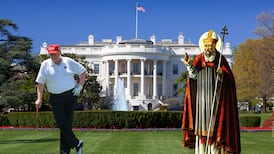Every day that I come into work I pass through one of the most evocative districts in the historic city of Dublin. I refer to Clanbrassil Street and environs, formerly a thriving Jewish community with many associations both historical and cultural, writes Deaglan de Breadun.
Thousands of people pass along Clanbrassil Street each day, busily oblivious to the ghosts of the past. There are a few clues, such as the plaque on Number 52, noting that James Joyce chose this address as the birthplace of the most famous Jewish character in prose fiction, Leopold Bloom.
The street is bisected by South Circular Road at Leonard's Corner. The lower part has lost much of its character thanks to a road-widening scheme. Where Jewish mommas clucked and gossiped, the almighty automobile now holds sway.
Upper Clanbrassil Street still looks the way it must have done in Joyce's time, though perhaps less bustling and a little more dowdy. This whole area was Dublin's "Little Jerusalem", lovingly chronicled in a recent book of that title by a senior member of the Jewish community, Nick Harris (published at €12.50 by A & A Farmar, Dublin).
I have a special affinity with this zone as a former pupil of the Christian Brothers in Synge Street, further along the South Circular Road. Its streets and side roads were part of the geography of my youth, explored by me and my friends after school as we sought diversion, entertainment and, frankly, just about any excuse not to go home to do our "ecker", as homework was called.
Harris's book adds a new dimension to my knowledge of the area. He confirms the folklore of my youth, that some Jewish boys had been educated in the past by the Christian Brothers, such as Louis Elliman of the famous Dublin theatrical family, who went to Synge Street. Harris himself was taught by the Brothers at Westland Row, with two of his co-religionists. "The Brothers were strict," he writes, "and the leather strap was used, but I was never punished and neither were the other Jewish boys."
Had my friends and I known about this in a later era, we would have considered changing our religion!
It is a heartwarming and reassuring story that Harris tells, for the most part. He never heard the expression anti-Semitism until he went to Manchester for a debate in 1932. He reveals that most Jewish boys followed Shamrock Rovers - The Hoops - on the soccer pitch. Had Ireland eased immigration restrictions in the 1930s, many Jews could have been saved from the Holocaust and Harris greatly regrets this. But he is not bitter and even allows, with what some would regard as excessive generosity, that the tight immigration policy may have been due to "the high rate of unemployment".
Whatever knowledge the Irish authorities may have had, he points out that even the Jews of Dublin did not know what was really going on, because of the very strict wartime censorship. A neighbour of his, Ettie Steinberg, died in Auschwitz in September 1942: five years earlier he attended her wedding, which he still remembers as "a joyous occasion, full of Jewish ritual and tradition".
Little Jerusalem is in stark contrast with another Jewish district which I visited last month in Budapest. The centrepiece of the old Jewish ghetto in the Hungarian capital is the Dohany synagogue, said to be the largest in the world. It survived the war largely unscathed; ironically this may be due to the fact that the Germans had an office in part of the building.
The site also marks the birthplace of the founder of modern Zionism, Theodor Herzl, and there is a Jewish museum with exhibits ranging from religious artefacts to a chilling display on the Holocaust in Hungary.
Memories of past atrocities are one thing, but what shocked me most was the fact that before you entered the synagogue, you had to pass through a metal detector under the gaze of a security guard. It was the same in the memorial park at the rear of the building.
There was a popular anti-Nazi slogan a few years ago, "The beast that bore them is in heat again." In post-communist Hungary, at the civilised heart of Europe, in the capital of a modernising state on the threshold of EU membership, it is sobering to see such precautions today against anti-Semitic attacks.
On a happier note, it emerged that much of the finance for the preservation and restoration of the Dohany synagogue came from the American movie actor and former matinée idol, Tony Curtis. Like the fictional Leopold Bloom, the star of Sweet Smell of Success and Some Like it Hot is the son of an Hungarian Jew and has poured large sums of money into remembering the victims of the Holocaust through the Emmanuel Foundation, named after his father, Emmanuel Schwartz.
Some 600,000 Hungarian Jews were murdered by Adolf Eichmann with some local assistance: they are remembered in a Curtis-sponsored "Tree of Life" at the rear of the synagogue. In the design of a weeping willow, the metal leaves carry the names of individual victims: the idea might be worth copying closer to home. The park is named after the Swedish diplomat, Raoul Wallenberg, the Schindler-like character who saved hundreds of Jewish lives and, in a cruel twist, later disappeared in the Soviet prison camp system.
Happily, Ireland never fell under the sway of the Nazis and this society's loyalty to its Jewish citizens was never put to the test. Had it been, my thoughts on the way to work every day might be less sentimental and a lot more tragic.








